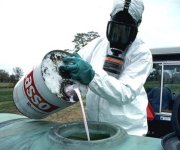The Dangers of Pesticides and the EPA's Harrowing Plan to Test Them on Kids
by SixWise.com
Pesticides are a ubiquitous toxin in our environment. We spray them liberally
on ants and spiders in our homes, use them in our gardens and on our lawns,
fog our streets with them to kill mosquitoes-even spread them on our own
bodies to keep bugs away.
|

Farmers use 1.5 billion pounds of pesticides every year-and most
have been found by the EPA to be carcinogenic.
|
But that's not all. American farmers use 1.5 billion pounds of pesticides
each year-that's 1.5 billion pounds of pesticides sprayed onto the food
that we, and our children, eat. And it's not just fruits and vegetables;
meats contain pesticides too because the animals eat feed that has been
heavily sprayed.
Plus, pesticides are used in many consumer products, including paints,
cosmetics, food packaging, fabrics, carpets and exercise mats. And they're
used extensively in parks and other recreational areas-golf courses are
some of the biggest offenders; in one year they use seven or eight times
the pesticides used on a comparable sized area of agricultural land.
The U.S. Environmental Protection Agency (EPA) has registered close to
900 pesticides, which are formulated into over 20,000 products, according
to the Northwest Coalition for Alternatives to Pesticides.
Some 60 percent of herbicides, 90 percent of fungicides and 30 percent
of insecticides are known to be carcinogenic, says the EPA, and these
pesticides contaminate our groundwater, our air and the very food we eat.
What Are the Health Effects of All These Pesticides?
Animal and human studies on individual pesticides have shown that they
contribute to an alarming number of health problems like:
- Cancer
- Fertility problems
- Brain tumors
- Childhood leukemia
- Non-Hodgkin's lymphoma
|
- Birth defects
- Irritation to skin and eyes
- Hormone or endocrine system problems
- Nervous system damage
|
Children are especially at risk from the toxic effects of pesticides.
Their bodies are still developing and immature, making them susceptible
to such damage. In fact, studies by the National Academy of Sciences and
the Environmental Working Group have found that children exposed to carcinogenic
pesticides are at a high risk of future cancer and other studies determined
that pesticide use was associated with an increased risk of childhood
malignancies.
Knowing this information, think, then, just how outrageous it is that
we shampoo our children with pesticides to kill head lice.
But all of these negative effects have been found largely from studies
that typically focus on one individual pesticide. Who, then, is studying
the cumulative effects on the body of all the various pesticides we're
exposed to, and that we consume, over years?
The EPA's Testing Pesticides on Kids?
That kids are so vulnerable to pesticide exposure is precisely why the
EPA chose them to study, and back in October 2004, they were given $2.1
million to do just that. Who were the granters of this large sum? The
American Chemistry Council, a chemical industry front group with such
big wigs as Monsanto, Exxon and Dow.
The two-year study-called the Children's Environmental Exposure Research
Study (CHEERS)-would monitor infants in low-income families to determine
how chemicals can be ingested, inhaled or absorbed by babies to children
up to age 3, as well as the health effects they would cause.
|

Families in the EPA's CHEERS pesticide study would receive a t-shirt,
video camcorder, bib, calendar, framed certificate, newsletter and
$970.
|
Surprisingly, the EPA chose to name the entirely serious study a flippant
"CHEERS." Study participants would receive $970, a t-shirt,
a bib for their baby, a calendar, a newsletter, a framed certificate of
appreciation and a video camcorder.
While the study does not require participants to change the level of
pesticides in their home, nor does it expose them to any additional chemicals,
it does require that they demonstrate a use of these toxic products in
their home. Opponents are concerned that low-income families will up their
pesticides use just to be involved in the study.
They also noted that since the study is partially industry-funded, it
represents a conflict of interest. Most effects of pesticides are seen
in the long-term, so it is unlikely that adverse effects will be seen
during the short-term study. The result would be that the chemical industry
could then claim an EPA study found their pesticides safe and push for
looser regulations for their use.
Said EPA Pesticide Scientist Troy Pierce, "This does sound like
it goes against everything we recommend at EPA concerning use of [pesticides]
related to children. Paying families in Florida to have their homes routinely
treated with pesticides is very sad when we at EPA know that [pesticide
management] should always be used to protect children."
In November 2004 the study was postponed, largely because of the public
controversy that arose around it, for a "final review" but is
scheduled to resume in spring 2005.
It is certainly a step in the right direction that the EPA is taking
strides to study the effects of pesticides that we're all exposed to.
However, their proposed "compensation" for participating in
this very serious study includes some gimmicky items: a free t-shirt,
bib and calendar? And it even has a gimmicky name (CHEERS?), which may
explain why the public was so alarmed when it appeared an industry-funded
study was seeking to draw in low-income families to monitor their use
of chemicals that the government already knows are toxic.
What's the Good News?
There is good news in all of this, and that is: It is possible to reduce
your exposure to pesticides (though, admittedly, you probably can't reduce
it to zero). The top ways to do this include:
-
Buy certified organic fruits, vegetables and meats (be sure to wash
produce, particularly commercially grown produce, thoroughly before
eating using a diluted soap solution)
-
Avoid the use of toxic pesticides in your home and yard (opt for
natural pesticides that you can find in your local health food store
instead)
-
Don't use pesticides for aesthetic purposes like dandelions in your
lawn
- Don't use chemical bug repellants or lice shampoos
Sources
Foods,
Beverages and Pesticides
Northwest
Coalition for Alternatives to Pesticides
EPA
and Chemical Industry to Test Toxic Chemicals on Children